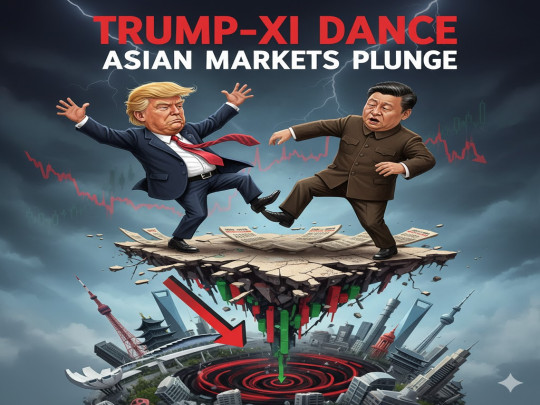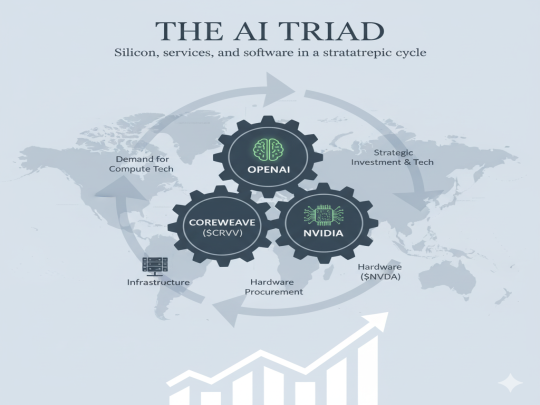Stock Market Update: Trump’s EU-Mexico Tariffs Shake Markets, Silver Hits 14-Year High, Bitcoin Rally Lifts Miners
Stock Market Update: Trump’s new tariffs on EU and Mexico spooked investors. Silver surged to a 14-year high, Bitcoin climbed past key levels, lifting Riot, CleanSpark, and MARA. Kenvue, Synopsys, and ANSYS led premarket gainers.

- Early Monday US stock futures pointed lower after President Trump announced 30% tariffs on all imports from the European Union and Mexico over the weekend, effective August 1.
- The announcement follows Friday's market pullback, which was triggered by new tariffs on Canada, leading all three major indices to close last week with losses.
- Significant premarket movers Monday included Kenvue (+4.5%) jumping after its CEO stepped down amid a strategic review. Synopsys (+4%) and ANSYS (+6%) rallied after China conditionally approved their merger. Bitcoin miners rose as BTC hit a new record. Rivian (-1.3%) and Affirm (-2.5%) fell on downgrades.
- The new 30% tariffs on the EU and Mexico came with warnings against retaliation. Both blocs have signaled a willingness to negotiate before the Aug 1 deadline.
- Key economic data showed China's June exports unexpectedly rose 5.8% YoY, beating forecasts, while imports edged up 1.1% for the first monthly gain of the year.
- In company news, Google poached key talent and tech from AI startup Windsurf in a $2.4B deal. Q2 earnings season begins this week, led by reports from major banks.
- Global markets Monday saw Europe decline on the tariff news, with auto stocks under pressure. Asia finished mixed as investors weighed the trade developments.
- US Treasury yields were little changed Monday morning (10-year around 4.423%) as bond investors showed a muted initial reaction to the new tariffs.
- Gold jumped to a three-week high on safe-haven demand, and Silver surged to a near 14-year high. Oil also rose on trade risks and strong China import data. Bitcoin soared to a new record high above $121,000.
- Investor sentiment soured again on the latest tariff salvo, though analysts note the reaction has been more muted than in April. Focus now turns to key US inflation reports this week and the start of Q2 earnings season.
Stock futures pointed lower Monday morning as markets reacted to the latest salvo in the U.S. trade dispute. President Donald Trump announced over the weekend that the United States will impose 30% tariffs on imports from the European Union and Mexico, effective August 1. The president revealed the measures in letters shared on Truth Social, directly addressing European Commission President Ursula von der Leyen and Mexico’s President Claudia Sheinbaum, cautioning both against retaliatory tariffs. Together, the EU and Mexico represent approximately one-third of total U.S. imports, adding considerable weight to the announcement’s potential market impact.
The decline followed Friday’s pullback on Wall Street, where equities fell sharply in response to Trump’s 35% tariff on Canada and broader threats of heightened duties on other trading partners. That downturn came just a day after the S&P 500 and Nasdaq Composite posted fresh record highs, highlighting the volatility tied to shifting trade headlines. All three major averages ended the week in negative territory, with the Dow dropping 1%, the S&P 500 down 0.3%, and the Nasdaq slipping 0.1%.
US Market Previous Day:
On Friday, the Dow Jones Industrial Average lost 279.13 points, or 0.63%, to finish at 44,371.51. The S&P 500 declined 0.33% to close at 6,259.75, while the Nasdaq Composite shed 0.22% to settle at 20,585.53. The losses marked a shift in sentiment as investors began to reassess risk amid a growing wave of protectionist trade actions that could weigh on global growth.
US Futures Remain Flat:
- Dow Jones Industrial Average futures remained flat with decline of 0.28%
- S&P 500 futures showed meagre losses of 0.26%
- Nasdaq Composite futures fell by 0.26%
Biggest Premarket Movers
- Kenvue: The Neutrogena-maker jumped 4.5% after the company announced that its CEO, Thibaut Mongon, has stepped down. Kenvue also stated its board is now conducting a strategic review of the company and is considering a range of possible alternatives, including simplifying its brand portfolio.
- nCino: The financial technology provider gained nearly 5% following an upgrade to "outperform" by the firm Baird. Analyst Joe Vruwink cited an upbeat outlook from the company's management, which highlighted a potential benefit from recent initiatives.
- Rivian Automotive: The electric vehicle company pulled back 1.3% after Guggenheim downgraded the stock to "neutral" from "buy" in a Monday note. Guggenheim analyst Ronald Jewsikow pointed to the likelihood of softer long-term sales for Rivian's upcoming R2 and R3 vehicles.
- SolarEdge Technologies: Shares rose nearly 2% after Barclays upgraded the company to "equal weight" from "underweight." The bank noted that despite anticipating a shrink in the overall market in 2026, SolarEdge is poised to achieve growth both this year and next.
- Bitcoin miners: Bitcoin mining stocks broadly advanced early Monday after the largest cryptocurrency by market capitalization, Bitcoin, reached a new all-time high above $120,000. Shares of Riot Platforms, CleanSpark, and MARA Holdings all rose 3% or more.
- Synopsys, ANSYS: Shares of semiconductor design company Synopsys added roughly 4%, while shares of ANSYS surged 6%. The moves came after Chinese regulators conditionally approved Synopsys's planned $35 billion acquisition of ANSYS.
- Affirm: Shares fell 2.5% after BTIG downgraded the buy-now-pay-later company to "neutral" from "buy." The firm reasoned that a loosening of underwriting standards from prime lenders such as Capital One and Synchrony will create a more competitive environment and likely hurt fintechs like Affirm.
- Fastenal: Shares gained 3% after the industrial supply company's second-quarter earnings surpassed analyst estimates. Fastenal reported earnings of 29 cents per share, while analysts polled by FactSet were looking for 28 cents.
Tariff Update:
President Donald Trump announced Saturday that the U.S. will impose a 30% tariff on goods imported from the European Union and Mexico, effective August 1. The announcement came via letters addressed to European Commission President Ursula von der Leyen and Mexican President Claudia Sheinbaum, which Trump publicly posted on his social media platform, Truth Social. In the letters, Trump offered exemptions for EU-based companies that manufacture products within the United States, positioning the tariff as a lever to onshore production. He also warned that any retaliatory measures by the EU or Mexico would trigger proportionate increases on top of the 30% base rate.
The move comes despite recent signs of progress in negotiations between the U.S. and its major trading partners. The EU had hoped to avoid being the next target of Trump’s sweeping tariff campaign, especially after the U.S. recently backed off a proposed 50% levy on the bloc. However, the letter sent over the weekend formalized the new 30% rate, despite preliminary efforts at de-escalation.
In response, leaders from both the EU and Mexico signaled a willingness to return to the negotiating table. European Commission President Ursula von der Leyen said on Sunday that the bloc would delay its retaliatory tariffs, originally set to take effect Monday, to allow time for talks aimed at securing a lower rate or avoiding the tariffs altogether. “This is now the time for negotiations,” von der Leyen stated, noting that Trump’s letter gives the EU a window until August 1 to strike a deal. EU trade ministers are set to meet Monday to coordinate their response and review talks with both the U.S. and China.
The stakes are high: the EU and Mexico combined account for about one-third of total U.S. imports. Europe’s key exports to the U.S. include pharmaceuticals, automobiles, aircraft, chemicals, medical devices, and premium alcoholic beverages—all sectors that could be significantly affected by the new duties.
The tariff escalation adds to a broader, increasingly aggressive trade agenda from the Trump administration. Following Thursday’s market close, Trump defended the higher tariff rate on Canadian imports by citing fentanyl concerns and warned that Canada could face even higher levies if it retaliates. In an interview with NBC News, he also floated the possibility of blanket tariffs ranging from 15% to 20% on all remaining U.S. trading partners—up from the current 10% baseline that markets had largely priced in.
Key Economic Data/News:
China’s export performance surprised to the upside in June, offering a rare bright spot amid ongoing global trade tensions. Exports rose 5.8% year-on-year in U.S. dollar terms, according to customs data released Monday, surpassing the 5% growth forecast in a Reuters poll. The upside was driven largely by stronger shipments to non-U.S. markets, and a temporary easing of tariff pressure from the United States also helped moderate the decline in goods bound for America. Exports to the U.S. still fell 16.1%, but that marked a substantial improvement from the 34% drop seen in May.
On the import side, China saw modest growth of 1.1% year-on-year, narrowly missing economists’ expectations of a 1.3% rise. Still, it was the first monthly increase in imports for 2025, signaling some stabilization in domestic demand after months of contraction. Imports from the U.S. declined 15.5% in June, a smaller drop than May’s 18% fall, as the tariff pause provided temporary relief.
Earnings Season/Company News:
Google’s acquisition of key personnel from AI startup Windsurf — including CEO Varun Mohan — marks another strategic move in Silicon Valley’s intensifying battle for artificial intelligence leadership. The $2.4 billion deal, which also includes a nonexclusive license to some of Windsurf’s proprietary technology, underscores Google’s commitment to enhancing its AI capabilities amid fierce competition from OpenAI, Meta, and Microsoft. Notably, OpenAI had reportedly been in talks to acquire Windsurf earlier this year for $3 billion, making Google’s successful poaching a significant win in the AI talent war.
Windsurf, while relatively young, had built a reputation for advanced foundational model architecture and was widely seen as a next-gen AI contender. Google’s move to bring in Windsurf’s top minds could signal an acceleration of product integration across its AI portfolio, including Gemini and its enterprise cloud offerings. This also comes at a time when AI research talent is increasingly being viewed as a core strategic asset — one that can meaningfully tilt the competitive landscape.
Meanwhile, attention is shifting to second-quarter earnings season, with investors watching closely to see how resilient corporate profits have remained amid trade tensions and interest rate uncertainty. Key earnings to watch this week include:
- Tuesday: JPMorgan Chase, Wells Fargo, Citigroup (before the bell)
- Wednesday: Goldman Sachs, Bank of America, Morgan Stanley, Johnson & Johnson, ASML (before the bell); United Airlines (after the bell)
- Thursday: PepsiCo (before the bell); Netflix (after the bell)
- Friday: American Express (before the bell)
Global Market Trends:
European stocks declined on Monday as investors digested escalating trade tensions and rising bond yields. The pan-European indexes slipped around 0.5%, with the euro hovering just below the $1.17 mark, largely unchanged from Friday’s close. Among sectors, the eurozone auto sector, seen as especially vulnerable to new U.S. tariffs, shed just over 1%, reflecting measured pressure despite the broader geopolitical concerns.
More pronounced moves were seen in the debt markets. German benchmark bond yields rose to their highest levels since April 1, while 30-year yields hit their highest point since October 2023. The uptick in yields was not directly linked to trade developments but may reflect broader inflationary concerns sparked by fears of a prolonged tit-for-tat tariff war. Those fears have stoked worries about potential stagflation in the eurozone. Traders also assessed French President Emmanuel Macron’s announcement to accelerate defense spending, pledging to double the military budget by 2027 — three years ahead of the previous schedule — despite existing budget constraints.
Asia-Pacific markets ended mixed on Monday as regional investors remained cautious amid the evolving global trade landscape. Hong Kong’s Hang Seng Index edged up 0.26% to finish at 24,203.32, while mainland China’s CSI 300 index was flat at 4,017.67. Japan’s Nikkei 225 dipped 0.28% to close at 39,459.62, while the broader Topix index was little changed at 2,822.81. South Korea’s Kospi gained 0.83% to end the day at 3,202.03, though the small-cap Kosdaq slipped 0.14% to 799.37. Australia’s S&P/ASX 200 benchmark declined 0.11%, finishing at 8,570.4.
Debt Market:
U.S. Treasury yields were largely steady Monday morning, as investors weighed the latest round of tariff announcements from President Donald Trump. The president’s weekend declaration of a 30% tariff on imports from the European Union and Mexico added to existing trade tensions, but failed to trigger a sharp reaction in bond markets.
The benchmark 10-year Treasury yield remained unchanged at 4.423%, reflecting a wait-and-see approach from investors ahead of key economic data due later in the week. The 30-year yield edged slightly higher, up just over a basis point to 4.971%, while the shorter-term 2-year yield slipped by 2 basis points to 3.891%, suggesting some movement into safe-haven assets amid continued geopolitical and trade uncertainty.
Commodities and Other Assets:
Gold surged to a three-week high on Monday, driven by safe-haven demand after U.S. President Donald Trump threatened steep new tariffs on the European Union and Mexico. The escalation in trade tensions pushed investors toward traditional safety assets, with gold leading the rally. Traders are also closely watching the upcoming U.S. consumer price index (CPI) and producer price index (PPI) reports, which could provide fresh clues on the Federal Reserve’s monetary policy outlook. Markets are currently pricing in 50 basis points of rate cuts by year-end, beginning in October. Gold typically benefits in a low-rate environment as the opportunity cost of holding non-yielding bullion diminishes.
Silver, meanwhile, stole the spotlight by climbing to a near 14-year high. In India, the world’s largest consumer of silver, domestic prices hit an all-time high of ₹114,875 ($1,336) per kg, as a production shortfall combined with surging demand from both investors and industrial sectors like solar energy and electric vehicles. Over the past three months, silver has risen 21%, outpacing gold’s 5% gain in the same period. The metal’s dual role—as a precious asset and an industrial input—continues to drive investor enthusiasm, especially amid tightening supply conditions.
Oil prices rose to their highest level in three weeks on Monday, underpinned by rising geopolitical risk and firm demand data. Investors responded to potential new U.S. sanctions on Russia, which may impact global crude supplies. Additionally, China’s crude imports in June jumped 7.4% year-on-year to 12.14 million barrels per day—the highest since August 2023—according to customs data released Monday. Russia's June seaborne oil product exports also declined 3.4% from May, further tightening the market. UBS analyst Giovanni Staunovo noted that expectations around further U.S. action against Russia, combined with robust Chinese demand, are likely to keep upward pressure on oil prices in the short term.
Bitcoin soared to a new record high, crossing $120,000 early Monday and trading at $121,921 as of 6:20 a.m. ET, according to Coin Metrics. The latest leg of the rally is being powered by record inflows into bitcoin ETFs, which brought in $1.18 billion on Thursday alone—the highest single-day inflow of the year. The surge has triggered a wave of short liquidations, amplifying the price move upward. Ether also rose nearly 7% to reclaim the $3,000 mark for the first time since February. Investors are also eyeing "Crypto Week" in Washington, D.C., as lawmakers are set to deliberate on several bills aimed at establishing a regulatory framework for digital assets. One key proposal, the Genius Act, would set federal standards for stablecoins tied to the U.S. dollar.
Market Sentiment:
Equity markets continue to show surprising resilience in the face of rising trade tensions, with investors appearing increasingly desensitized to tariff threats. Last week’s barrage of tariff announcements by U.S. President Donald Trump—including steep levies on Canada, the EU, and Mexico—triggered only modest pullbacks, in stark contrast to the pronounced market volatility seen in April when Trump first unveiled his sweeping “reciprocal tariff” policy.
Barclays noted in a Friday client note that “markets have become increasingly de-sensitive to tariff threats, and do not take high tariff rates for granted any more.” The bank observed that recent reactions suggest investors are interpreting the latest measures as more strategic than structural—negotiation tactics rather than imminent economic shocks. However, Barclays warned that “the impact on growth and inflation down the road is yet to be seen,” particularly if harsher measures like the 50% tariffs on Brazil prove durable rather than symbolic.
Investors are now looking ahead to a critical week for economic data. June’s Consumer Price Index (CPI) report is due Tuesday, followed by the Producer Price Index (PPI) on Wednesday. These inflation readings will offer important clues about the economic impact of recent tariffs and shape expectations for the Federal Reserve’s next policy moves.
Meanwhile, political friction surrounding Fed independence is back in focus. Over the weekend, National Economic Council Director Kevin Hassett suggested that the Trump administration could fire Fed Chair Jerome Powell “if there’s cause,” reviving uncertainty over the central bank’s autonomy. The remarks have heightened market sensitivity around upcoming Fed communications, especially as rate cut expectations build for the second half of the year.



